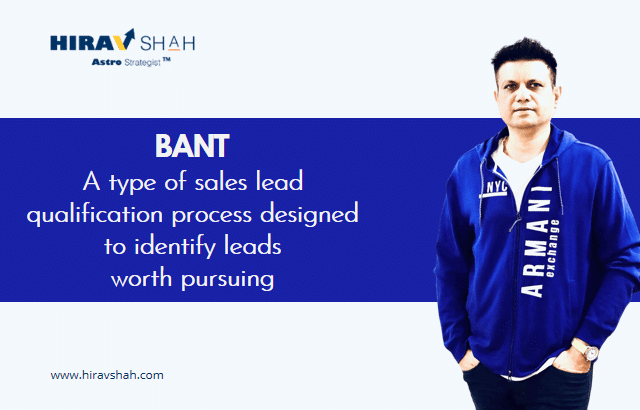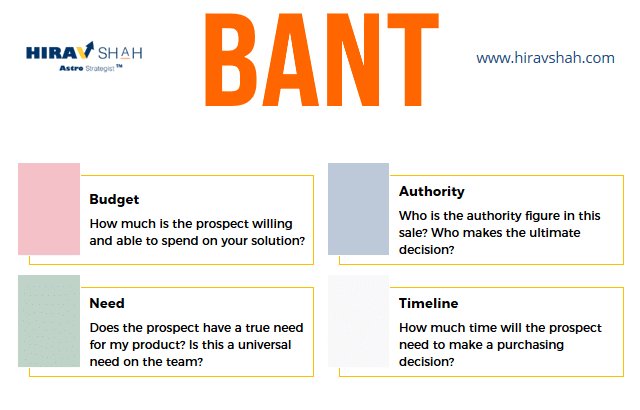BANT is a descriptor that stands for “Budget, Authority, Need, Timeline.”
BANT provides a simple model for measuring up prospects in a business-to-business (B2B) sales setting.
An administration evaluates whether, and to what degree, a sales prospect meets each of the four criteria.
Table of Contents
Tips and Tricks for Effective Lead Identifying in Sales and Marketing
Some leads may be hot, warm or cold. But you don’t really know this until you qualify the same.
There are several lead qualification procedures/approaches out there. However, in being one of the best, BANT has stood the test of time.
No, seriously…
What does BANT stand for ?
- B stands for budget, A stands for Authority, N stands for Need & T stands for Timeline.
- BANT is a framework that sales representatives can use to find out how qualified a lead is, to work with your organization and determine which leads they should concentrate on.
- In other words, BANT is a famous tool sales leaders mostly used to aid them to figure out whether their prospects have the budget, authority, need, and right timeline to buy what they are selling.
Let’s Understand Budget, Authority, Need, Timeline step by step.
B stands for Budget
- The first component of BANT is Budget. This refers to the financial resources that a lead has available to make a purchase.
It’s important to identify whether a lead has the budget to make a purchase before investing time and resources into the sales process. - If you were a car dealer, your first question when someone walks onto your lot would be about budget, right? You wouldn’t try to sell a Mercedes to someone with a Maruti budget.
- When your prospect doesn’t have the budget for your product/service and there’s no way around it, the deal won’t pan out.
One way to determine a lead’s budget is to ask qualifying questions about their financial situation and the resources they have available for the purchase. - Another approach is to research the lead’s company and industry to get a sense of their typical budget for similar purchases.
A stands for Authority
- The second component of BANT is Authority. This refers to the decision-making power that a lead has within their organization.
- It’s important to identify whether a lead has the authority to make a purchase decision or if they need to consult with others in their organization.
- One way to determine a leader’s authority is to ask qualifying questions about their role and responsibilities within their organization.
- Another approach is to research the lead’s company hierarchy and decision-making processes to understand who has the final say in purchasing decisions.
N stands for Need
- The “N” in BANT stands for Need. This refers to the lead’s current pain points or challenges that they are looking to solve.
- It’s important to understand the lead’s specific needs so that you can tailor your sales pitch or marketing message to address those needs.
- One way to identify a lead’s needs is to ask open-ended questions about their business or industry, and listen carefully to their responses.
- Additionally, you can research the lead’s company and industry to understand common pain points and challenges that they may be facing.
T stands for Time
- The “T” in BANT stands for Timeline. This refers to the lead’s timeline for making a purchase or decision.
- It’s significant to understand when the lead is looking to make a decision so that you can prioritize your sales efforts accordingly.
- If the lead has a short timeline, you may need to move quickly to provide them with the information and resources they need to make a decision.
- On the other hand, if the lead has a longer timeline, you may have more time to nurture the relationship and provide additional information and support.
Merits and Demerits of using BANT
- While BANT can be a powerful tool for identifying high-quality leads, it’s essential to recognize its limitations.
- However, when used effectively, BANT can help sales and marketing teams prioritize their efforts and focus on the leads that are most likely to convert into customers.
Final Thoughts
BANT is a strategy that employs sales-basics for creating criteria to ascertain if a prospective customer will ever become a customer.
BANT: Sales Qualification Questions To Ask
Budget: Is Your Solution A Priority For Your Prospect
Questions
- How much would you spend on similar products/services?
- Who is in charge of financial decisions?
- How much money is budgeted for this solution?
Authority: Understand Their Decision-Making Process
Questions
- What is your decision-making process?
- How can I help you meet your expectations?
- Who on your team would be using this solution?
- What are their values? Obstacles?
Need: How To Gauge Their Pain Level
Questions
- What does your current process look like?
- Where do you run into hurdles?
- What problems are you trying to solve by looking at solutions like ours?
- How often do you run into those problems?
- How much do they bother you on a scale from 1 to 10?
Timing: Find Out How Soon They’re Willing To Act
Questions
- Walk me through the evaluation process. How long have you been looking for a solution?
- What types of time constraints are you working with?
- What are the implications if you don’t meet the timeline?
- Are there any contracts from other solutions you’re already signed to? Until when?

















